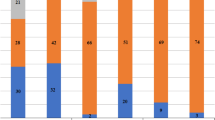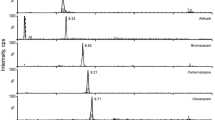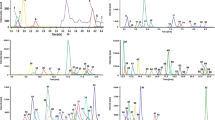Abstract
Purpose
In the present study, a method for the detection of 25 psychoactive substances in cerumen was developed and validated. This method targets opiates, cocaine, antidepressants, benzodiazepines, antipsychotics and antiparkinsons.
Methods
Analysis was performed on a SCIEX Triple Quad 6500+ system after liquid–liquid extraction. Methanol with 1% acetic acid was chosen as the extraction solvent. After the addition of the solvent, samples were vortexed, sonicated, centrifuged and directly injected into the liquid chromatography–tandem mass spectrometry system.
Results
The method was found to be selective and sensitive (limit of detection: 0.017 ng–0.33 ng/mg), the assay was linear for all analytes with linear regression coefficient ranging 0.9911–1.00. The values for intra-assay precision was between 4.34 and 14.6% and inter-assay precision between 5.81 and 17.7%, with accuracy within the acceptable criteria for all analytes. All analytes in cerumen specimens were stable for 48 h at 4 °C and 72 h at − 20 °C, whilst no significant matrix effect or carryover was observed. Applicability was proven by analyzing cerumen samples from 25 deceased with a history of drug abuse. All analytes were detected in real samples, thus confirming the sensitivity of the developed method.
Conclusions
According to our knowledge, it is the first time that a method for the simultaneous detection of 25 psychoactive drugs in cerumen was developed, fully validated and finally applied to 25 postmortem samples.


Similar content being viewed by others
References
Pragst F, Balikova MA (2006) State of the art in hair analysis for detection of drug and alcohol abuse. Clin Chim Acta 370(1–2):17–49
Solimini R, Minutillo A, Kyriakou C, Pichini S, Pacifici R, Busardo FP (2017) Nails in forensic toxicology: an update. Curr Pharm 23(36):5468–5479. https://doi.org/10.2174/1381612823666170704123126
Hartwig S, Auwärter V, Pragst F (2003) Effect of hair care and hair cosmetics on the concentrations of fatty acid ethyl esters in hair as markers of chronically elevated alcohol consumption. Forensic Sci Int 131(2–3):90–97. https://doi.org/10.1016/s0379-0738(02)00412-7
Schubert W (2013) Urteilsbildung in Der Fahreignungsbegutachtung: Beurteilungskriterien, 3rd edn. Kirschbaum, Bonn
Cappelle D, Yegles M, Neels H, Nuijs ALN, Doncke M, Maudens K, Covaci A, Crunelle CL (2014) Nail analysis for the detection of drugs of abuse and pharmaceuticals: a review. Forensic Toxicol 33(1):12–36. https://doi.org/10.1007/s11419-014-0258-1
Roeser RJ, Ballachanda BB (1997) Physiology, pathophysiology, and anthropology/epidemiology of human earcanal secretions. J Am Acad Audiol 8(6):391–400
Makino K, Amatsu M (1986) Epithelial migration on the tympanic membrane and external canal. Arch Otorhinolaryngol 243(1):39–42. https://doi.org/10.1007/BF00457906
Naiberg JB, RobinsonA KP, Hawke M (1992) Swirls, wrinkles and the whole ball of wax (the source of keratin in cerumen). J Otolaryngol 2:142–148
Guest JF, Greener MJ, Robinson AC, Smith AF (2004) Impacted cerumen: composition, production, epidemiology and management. QJM 97:477–488
Stoeckelhuber M, Matthias C, Andratschke M, Stoeckelhuber BM, Koehler C, Herzmann S, Sulz A, Welsch U (2006) Human ceruminous gland: ultrastructure and histochemical analysis of antimicrobial and cytoskeletal components. Anat Rec Part A 288:877–884. https://doi.org/10.1002/ar.a.20356
Shokry E, MarquesJG RPC, Pereira NZ, Filho NRA (2017) Earwax as an alternative specimen for forensic analysis. Forensic Toxicol 35(2):348–358. https://doi.org/10.1007/s11419-017-0363-z
Meier SI, Koelzer SC, Zsilavecz MS, Toennes SW (2017) Analysis of drugs of abuse in cerumen - correlation of postmortem analysis results with those for blood, urine and hair. Drug Test Αnal 9(10):1572–1585. https://doi.org/10.1002/dta.2177
Stepanov I, Feuer R, Jensen J, Hatsukami D, Hecht SS (2006) Mass spectrometric quantitation of nicotine, cotinine, and 4-(methylnitrosamino)-1-(3-pyridyl)-1-butanol in human toenails. Cancer Epidemiol Biomarkers Prev 15:2378–2383
MeierSI SSP, Zsilavecz MS, Fernandes Perna ES, Theunissen EL, Ramaekers JG, Toennes SW (2020) Analysis of 4-fluoroamphetamine in cerumen after controlled oral application. Drug Test Anal 12:968–974. https://doi.org/10.1002/dta.2796
Shokry E, de Oliveira AE, Avelino MAG, de Deus MM, Pereira NZ, Filho NRA (2017) Earwax: an innovative tool for assessment of tobacco use or exposure. A pilot study in young adults. Forensic Toxicol 35(2):1–10. https://doi.org/10.1007/s11419-017-0370-0
Nicolaou AG, Stavrou IJ, Louppis AP, Constantinou MS, Kapnissi-Christodoulou C (2021) Application of an ultra-performance liquid chromatography-tandem mass spectrometric method for the detection and quantification of cannabis in cerumen samples. J Chromatogr A 1642:462035. https://doi.org/10.1016/j.chroma.2021.462035
Orfanidis A, Raikos N, Brousa E, Zangelidou E, Mastrogianni O (2021) Determination of lidocaine in postmortem whole blood samples after unsuccessful cardiopulmonary resuscitation. Seperations 8(8):117. https://doi.org/10.3390/separations8080117
Orfanidis A, Gika HG, Theodoridis G, Mastrogianni O, Raikos N (2021) A UHPLC-MS-MS method for the determination of 84 drugs of abuse and pharmaceuticals in blood. J Anal Toxicol 45(1):28–43. https://doi.org/10.1093/jat/bkaa032
Cao Z, Kaleta E, Wang P (2015) Simultaneous quantitation of 78 drugs and metabolites in urine with a dilute-and-shoot LC–MS-MS assay. J Anal Toxicol 39:335–346. https://doi.org/10.1093/jat/bkv024
Matuszewski BK, Constanzer ML, Chavez-Eng CM (2003) Strategies for the assessment of matrix effect in quantitative bioanalytical methods based on HPLC-MS/MS. Anal Chem 75:3019–3030
Peters FT, Drummer OH, Musshoff F (2007) Validation of new methods. Forensic Sci Int 165:216–224
Scientific Working Group for Forensic Toxicology (SWGTOX) (2013) Standard practices for method validation in forensic toxicology. J Anal Toxicol 37(7):452–474
Garside D, Ropero-Miller JD, Goldberger BA, Hamilton WF, Maples WR (1998) Identification of cocaine analytes in fingernail and toenail specimens. J Forensic Sci 43(5):974–979
Engelhart DA, Jenkins AJ (2002) Detection of cocaine analytes and opiates in nails from postmortem cases. J Anal Toxicol 26:489. https://doi.org/10.1093/jat/26.7.489
Phipps RJ, Smith JJ, Darwin WD, Cone EJ (2008) Handbook of analytical separations. Elsevier B.V., Amsterdam, p 6. https://doi.org/10.1016/S1567-7192(06)06002-5
Acknowledgements
The authors wish to acknowledge the technical employees of the Forensic Service of Thessaloniki for providing the biological samples.
Author information
Authors and Affiliations
Corresponding author
Ethics declarations
Conflict of interest
The authors declare that they have no conflict of interest.
Ethical approval
All procedures performed in this study were in accordance with the ethical standards of the national committee and with the 1964 Declaration of Helsinki. Biological fluids (blood, urine) and cerumen collection from decedents was made by judicial authorities, and the samples were sent to our institute for toxicological analysis at their request. This article does not contain any studies with living human participants or animals performed by any of the authors.
Additional information
Publisher's Note
Springer Nature remains neutral with regard to jurisdictional claims in published maps and institutional affiliations.
Supplementary Information
Below is the link to the electronic supplementary material.
Rights and permissions
Springer Nature or its licensor holds exclusive rights to this article under a publishing agreement with the author(s) or other rightsholder(s); author self-archiving of the accepted manuscript version of this article is solely governed by the terms of such publishing agreement and applicable law.
About this article
Cite this article
Mastrogianni, O., Orfanidis, A., Brousa, E. et al. Development and validation of an ultra-performance liquid chromatography–tandem mass spectrometric method for the determination of 25 psychoactive drugs in cerumen and its application to real postmortem samples. Forensic Toxicol 41, 94–104 (2023). https://doi.org/10.1007/s11419-022-00640-y
Received:
Accepted:
Published:
Issue Date:
DOI: https://doi.org/10.1007/s11419-022-00640-y




